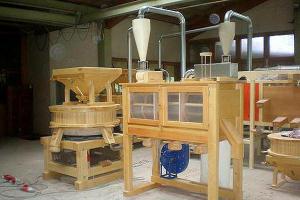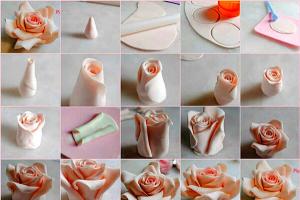To make flowers last longer in a vase. -Cut flowers for a bouquet early in the morning or late in the evening, and during cloudy times - during the day. -The safety of flowers depends on the number of leaves left (there should not be more than 3), and on the phase of flower development at the time of cutting. - The stems must be cut or broken off in a container with water, removing the lower leaves. Hard stems are flattened with a hammer. All leaves are removed from shrubs. -The stems of roses, dahlias, and poppies are lowered for 30 seconds. into boiling water, and then into a vase of water. The stems of dahlias, gerberas, mallows, daisies, and hydrangeas are quickly burned over a fire and only then placed in water. -If the bouquet is wilted, you can revive it by removing excess leaves, renewing the cut, sprinkling cold water, wrapping the heads in a damp cloth, and placing the entire bouquet in a bucket of warm water (without allowing the flowers themselves to submerge). - Use only clean, preferably soft water and change it daily. - The water level in the vase has an important impact on the bouquet. For freesias you need 5 cm, for gerberas - 5-8 cm, for roses, irises, chrysanthemums, tulips - 10 cm, carnations and daffodils - 10-15 cm of water level. - You can add a little vinegar to the water, citric acid or drop a copper coin. - Not all flowers can stand in a vase with others. And it happens that the same flowers, but different varieties, cannot get along. A bouquet of identical flowers is best. -The place where the bouquet stands also has a big influence. Do not place it in the sun or drafts. - Optimal temperature indoors plus 18-20 degrees. At night it is better to take the bouquet to a cooler place. -Cut flowers for a bouquet early in the morning or late in the evening, and during cloudy times - during the day. -The safety of flowers depends on the number of leaves left (there should not be more than 3), and on the phase of flower development at the time of cutting. - The stems must be cut or broken off in a container with water, removing the lower leaves. Hard stems are flattened with a hammer. All leaves are removed from shrubs. -The stems of roses, dahlias, and poppies are lowered for 30 seconds. into boiling water, and then into a vase of water. The stems of dahlias, gerberas, mallows, daisies, and hydrangeas are quickly burned over a fire and only then placed in water. -If the bouquet is wilted, it can be revived by removing excess leaves, renewing the cut, sprinkling with cold water, wrapping the heads in a damp cloth, and lowering the entire bouquet into a bucket of warm water (without allowing the flowers themselves to submerge). - Use only clean, preferably soft water and change it daily. - The water level in the vase has an important impact on the bouquet. For freesias you need 5 cm, for gerberas - 5-8 cm, for roses, irises, chrysanthemums, tulips - 10 cm, carnations and daffodils - 10-15 cm of water level. - You can add a little vinegar, citric acid or a copper coin to the water. - Not all flowers can stand in a vase with others. And it happens that the same flowers, but different varieties, cannot get along. A bouquet of identical flowers is best. -The place where the bouquet stands also has a big influence. Do not place it in the sun or drafts. - The optimal room temperature is plus 18-20 degrees. At night it is better to take the bouquet to a cooler place.
The brightest autumn flower, which migrated from royal parks to grandmothers' gardens - these are dahlias. I can say unequivocally about it: if you want, cut it into bouquets, or if you want, let it make you happy in the garden - it’s good everywhere. Dahlias have cut varieties, but even they will not last in a vase for more than 5 days, but there are garden varieties, and no matter what you do, another day they will hang their heads. All pompom dahlias stand well in water, medium (Evelyn, Barbarossa), large (Tartan, White Perfection, Vulcan), but these are the ones I grow, you can add to this list yourself.


Have you decided to cut it? We go to the bush and take a bucket of water: a freshly cut dahlia should be immediately placed in water. FULLY OPENED FLOWERS are used for cutting; if they are half-opened, the buds will not stand in water; if we do not cut them in dew or rain, the petals will rot (or shake them off very well and “dry” them in the house). The larger the “head” of the flower, the longer the “leg” should be, the more harmonious it looks. Therefore, you must prepare flowers for cutting in advance.



photo marusja0109
The dahlia produces three flowers at once, one larger, but the original leg is shorter, and two almost identical, but smaller than the central one, but the “legs” are longer. Decide for yourself what to leave. If you leave the central one, remove the two lateral ones at the bud stage, go down the stem, decide on the length of the leg and in this segment we remove all the stepsons, leaving the leaves. (In general, you need to look after the dahlia bush and monitor the number of stepsons in principle, but most they don’t pay attention to this and maybe this is also why they love dahlias, it seems that the more magnificent the better, but this is a separate topic in caring for dahlias) In this case, by the time of cutting you will have a tall and thick leg and a very large flower. Very often the head is so large that the stem cannot support the weight and bends; you can play it safe and insert a willow or bird cherry twig inside the hollow stem; a lilac shoot will also do. Willow is better, it even disinfects water. There should be more water in a vase with dahlias, the flow of moisture from flowers comes from the place of cut, and from dahlias it is also along the inner walls of the hollow stem, for this they even pour water inside the stem and plug it with cotton wool, there are a lot of petals, they evaporate a lot of large moisture, you can drink it yourself I want to. and sufficient quantity of water is required.
Chapter 44. To make cut flowers last longer
Cut flowers require careful care, which will prolong their life, and give you the joy of contemplating their extraordinary beauty. People's ingenuity and observation provide the answer to the question: “What should be done to make cut flowers last longer?” We offer you only tested and proven methods of caring for cut flowers.
The general rule: in order for flowers to last longer in a vase, they need to be cut early in the morning, before the rays of the sun have time to “wake up” the buds. After a cool night, flowers store vital moisture and will feed on it for a long time. The cut on the stem should be longitudinal. This will increase the possibility of feeding the cut flower.
It is known that peonies, daffodils and tulips do not tolerate “life” in a vase. Already after 2-3 days after cutting, they begin to lose petals and slowly fade. Of course, it is almost impossible to preserve lush blooming peonies and tulips in a vase for a long time, because even in the garden they do not please the eye for long. And if you want your bouquet to last longer, then choose peonies and tulips that have not yet bloomed in full force. A bud that has just swelled to bloom will bloom and fade in the vase. Thus, the most outlandish and beautiful thing will happen before your eyes - a flower will bloom.
Flowers, which are known for their short lifespan in captivity, should receive as much nutrition as possible from water. To do this, add citric acid and charcoal to the water (per 1 liter - 0.5 g of citric acid, 1 g of charcoal). Change the water every day, in the evening. Sprinkle the buds with water room temperature only when the flowers “fall asleep” will they cover their buds a little. During the wilting period, change the water in the vase with the addition of the above-mentioned drugs twice a day.
Unlike peonies and tulips, dahlias should be cut no earlier than the flower has almost completely bloomed. Fill the hollow flower stems with water and seal with cotton wicks. This way you will provide the dahlias with additional nutrition. Add aspirin to a vase of water for dahlias (1 tablet per 1 liter). Dahlias can last quite a long time if only the “bare” stems are in the water, so remove the leaves from the part of the stem that will be in the water.
Cut gladioli immediately after 2-3 flowers open. Pierce the part of the stem that will be in the water several times with a thick needle, and pinch off the lower bud - this will delay the flowering of the upper buds and prolong the life of the bouquet. Lilies are cut when 1-2 flowers from the inflorescence have bloomed. To make these beautiful flowers last longer, place the ends of the stems in hot water(about 60°C) for 1–2 minutes. Add a little citric acid to the water. After 2-3 days, remove the stamens from the flowers, this will prolong their life.
Extraordinary flowers - callas - will decorate your room for a long time if you make longitudinal sections on the flower stems under water and then rub dry salt into the cut.
Gerberas with a hairy stem are afraid of drafts, so choose for them appropriate place in my house. They should be placed in salt water (1 teaspoon per 1 liter of water) so that the water covers only 1/3 of the stem. Chrysanthemums and asters will last longer if, when changing water, the ends of the stem are not cut off, but cleaned of decaying particles with a stiff brush. Split the branches of lilac and jasmine at the bottom of the stems and insert fragments of matches into the splits so that their edges do not meet. This will provide the flowers with the right amount of moisture.
Flowers that secrete milky juice from the stem after being cut should be placed in warm water so that the juice does not thicken and interfere with the absorption of moisture. Cloves stand well in sugared water; a 15% sugar content is suitable for them. Long shelf life pansies and chamomile, if you put them in lightly sugared water and burn the ends of the stems over a candle or burner. Many flowers that grow as shrubs are well preserved in water containing 5% potassium permanganate.
The last aid to a fading bouquet can be a small piece of quicklime, ammonia or camphor alcohol. If you want to save a hopelessly fading bouquet, then dilute 0.5 tsp. ammonia or camphor alcohol in 1 liter of water and place a bouquet with freshly cut stems in this water.
Roses are considered royal flowers, because even when cut, they require painstaking care. Many people regret that the life of cut roses is short. But there are a few secrets that will help you keep roses blooming and fresh for a long time. Try to bring roses that are a little wilted in a vase back to life using the method outlined below, thereby you will prolong the joy of the beauty of roses for another 4-5 days. If you follow all the care rules, you can save beautiful bouquet roses for 10–12 days.
First, prepare a vase for the bouquet. It should hold enough water for the bouquet, so that the flower stems can be in the water for half their length. Before placing roses in a vase, rinse it with a weak vinegar solution. To do this, add 0.5 tsp to 0.5 cup. table vinegar. A vase treated in this way will be spotlessly clean and sterile, which will prevent rapid stagnation of water.
If the roses are “tired” from the road, then give them a rest before putting them in water. To do this, fill a basin or bath with a certain amount of water at room temperature, wrap the buds in well-moistened paper and place the roses in the water “at full height.” Make sure that the buds do not press on each other, let the flowers lie freely. Directly under water, cut a 4-5 mm cone of the stem with a sharp knife. After 15–20 minutes, carefully remove the flowers from the water and remove the paper.
Fill the vase with purified or distilled water, filling 2/3 of the vessel. For roses, water should be at room temperature both in summer and winter. It is not recommended to take water directly from the tap: as you know, it contains a high content of chlorine and other substances harmful to plants.
Give it time to settle or pass it through a filter. Dissolve an aspirin tablet in water. Only now can you put the bouquet in the vase.
Change the water in the vase every two days, do not forget to trim the stems a little each time and put an aspirin tablet in the water. Spray leaves and buds periodically warm water. When the roses in the bouquet begin to fade a little, give them a “night rest.” Fill a basin or bath with slightly warm water and place roses in them so that only the flowers are above the water. Wrap the rosebuds in soaked paper and secure them under the sepals. Let the roses rest until the morning in a dark, cool room. And in the morning, before returning the bouquet to the vase, cut off the tip of the stem again by 5–7 mm.
“Night baths” for roses should become regular if the flowers begin to noticeably “give up.” To prevent rose petals from going to waste, secure the buds by wrapping them in pretty wrapping paper or cellophane wrap. This can be done carefully and with artistic taste, then the bouquet will sparkle with new, original colors.
If the bouquet is very dear to you as a memory of some significant event or of a dear person who presented it to you as a sign of his bright feelings, then you can give the flowers a second, almost eternal life. After the gifted bouquet has been in the vase for 2-3 days with proper care, remove it from the water and liberally pour strong-hold hairspray onto the buds, stems and leaves of the roses.
| |
Extending the life of cut flowers is not so difficult - just follow some simple tips.
123RF/zamuruev
Preparing the bouquet
Choose a vase according to the size of the bouquet so that the stems of the flowers are not pressed against each other. It is better to fill the vase not from the tap, but to use settled or filtered warm water.
For all colors, follow the main rule: Before placing the bouquet in a vase, remove the lower leaves from the stem, and the roses also have thorns, to avoid rotting in water.
For flowers with a hard stem (roses, chrysanthemums), use a sharp knife to make an oblique cut to increase the area for moisture absorption. This procedure must be done under water so that air bubbles do not clog the vessels of plant tissues. Do not use scissors for this so as not to flatten the capillaries. Split the stem three to four centimeters and insert a piece of a match into the split - this will further enhance the absorption of moisture.
For flowers with a hollow stem (dahlias, lupins), pour water inside the stem and plug the hole with cotton wool or a piece of gauze. Remove all leaves from the branches of shrubs (lilac, jasmine) and split the tip of the trunk.
A flower that secretes milky juice must be cut under water, since in air it immediately hardens, clogging the blood vessels. To stop the secretion of juice, the end of the stem must be dipped in boiling water for a couple of seconds or burned over a fire.
For soft-stemmed plants (tulips, daffodils, calla lilies, gladioli), cut the bottom of the stem or make several vertical scratches on it with a needle. Treat sections of calla lilies and gerberas with salt, and dip the stems of carnations in alcohol for a few seconds.

123RF/Nelli Syrotynska
Disinfection and fertilizing
Flowers in a vase suffer most from the rapid development of bacteria in the water. Various ways disinfection slows down this process. Place pieces of charcoal, a silver coin into the water, as they did in the old days, or add washing powder on the tip of a knife. For the same purpose, you can lightly salt the water in a vase of flowers (one teaspoon of table salt per liter of water).
To destroy microorganisms, add aspirin or streptocide to the water for flowers (one tablet per six liters of water), sugar and vinegar (one tablespoon per liter of water), boric acid(0.1 grams per liter of water), soda slaked with lemon juice (no more than one tablespoon per liter of water), potassium permanganate (on the tip of a knife). All these means help destroy microorganisms in water, prevent the process of decay and allow fresh flowers not to fade for a long time.
To feed flowers in a vase, sugar is usually used. This especially helps tulips, carnations, and daffodils. Roses and chrysanthemums respond positively to aspirin, but for dahlias it’s a good idea to add a little vinegar to the water. But the aster feels much better in a weak alcohol solution (one teaspoon of alcohol per liter of water).
Besides, in flower shops special additives are sold to extend the life of flowers. They already contain all the necessary disinfectants and nutrients.

123RF/Konstantin Malkov
How to place a bouquet?
Flowers should be kept in a bright room, avoiding direct sunlight. It is also undesirable for there to be drafts in the room. Important role The temperature in the room also plays a role: in a cooler climate, flowers are preserved better.
Roses, carnations, orchids, lilies, daffodils, poppies, lilies of the valley should be placed in vases separately from other flowers, then they will last longer. Sprigs of geranium, thuja, and woodruff, on the contrary, help keep flowers fresh.
Do not place the vase near the place where fruits are stored: fruits emit ethylene gas, which accelerates the rotting process.
To make flowers last longer
To extend the life of your bouquet, regularly change the water, rinse the walls of the vase and wash the stems of the flowers. After removing the bouquet from the vase, trim the stems by a centimeter, holding them under running water, and only then place them back in fresh water. To keep the greenery of the flowers fresh, spray them from time to time with a spray bottle.
To make new buds open faster, periodically remove old dried flowers. The flowering process can be significantly accelerated by adding a little vodka to the vase.
If several flowers in the bouquet begin to fade earlier than others, select fresh ones, wash, trim and place in another container. Plants with signs of wilting are lowered into water up to the flower.
There is also emergency method help flowers: Place the stems in boiling water for a few seconds. Hot water will expand the capillaries and activate vital processes.
Do you like cut flowers?
Vote
A luxurious bouquet of roses given for a birthday, modest daisies collected in a field, charming garden gladioli - why can’t they please the eye for a long time? But - alas! The life of cut flowers in a vase is short-lived: a day, another, and it fades away, yesterday’s still blooming life. We want to tell you little secrets on how to preserve cut flowers.
They are also alive - meadow cornflowers, bluebells, garden dahlias, tulips, roses grown in greenhouses, chrysanthemums. They also know how to breathe. Scientists have proven that when cutting plants experience severe stress, their breathing rate first decreases, and then, on the contrary, it becomes more frequent. Once - and life beautiful flower broke off.
The reason for the rapid death of cut flowers is dehydration. It seems absurd, because the flowers are in the water. Yes, only this water does not penetrate the stems well: when cut, the small vessels located in the stems of the flower become clogged with air bubbles.
The unusual, uncomfortable temperature for the flowers also has an effect. You've probably seen that in flower boutiques there are roses and chrysanthemums in the refrigerators? Most flowers, after cutting, are better preserved at a temperature of 5-7ºС, and some are more comfortable at even lower temperatures:
How to keep cut flowers alive
When you bring a bouquet into your home, follow these simple rules:
- Trim the flower stems in the water with a sharp knife, making a cut at an angle so that air bubbles do not clog the vessels.
- Leave the flowers in a cool place for a while - this way they will recover from stress and their tissues will be saturated with moisture.
- Before putting the bouquet in water - settled, without chlorine! – trim the stems again.
- The lower leaves of flowering plants left on the stem will rot in water, so try to remove the lower leaves before placing the flowering buds in a vase. This will help avoid the active development of bacteria in the water.
- For the same purpose, a variety of antibacterial drugs are used. Probably everyone knows that it is recommended to add aspirin and charcoal to a vase of flowers. But why is unknown. And coal, and a silver coin, a pinch of washing powder - just a little - disinfect the water, destroying harmful bacteria. Among folk remedies– regular salt: per 1 liter of water – 1 teaspoon. Simple “wisdom” will help keep water fresh and extend the life of cut flowers. Important: Flower shops have preparations containing disinfectants and nutrients - “Crysal”, “Bud” and the like. They will help preserve your bouquet longer.
- Roses have a hard stem. Before putting them in water, you need to split it and put a match into the split.
- First, water is poured into the hollow stem of lupins and dahlias, and then the hole is covered with cotton wool or gauze.
- All leaves of the lilac are removed, and the end of the branch must be crushed with a hammer.
- If the plant secretes milky sap, the end of the stem is burned with boiling water or a match.
How to preserve blooming beauty

Alstroemeria
The very first rule is fresh water. You need to change it in the vase every day, not forgetting to add aspirin, charcoal, and sugar. The latter is needed for feeding flowers. It will help carnations and spring flowers - daffodils, tulips to stand in water longer - up to a crescent, chrysanthemums, roses - an aspirin tablet will help to please the eye longer, and dahlias do not mind vinegar “feeding”. Asters, without ceremony for a long time, ask for... vodka. Alcohol solution - 1 teaspoon per 1 liter of water - and asters will last a long time.
Place the donated roses wrapped in paper in a cool place for a couple of hours, immersing them in water almost up to their heads. They will be saturated with moisture and will not experience extreme stress.
A peony cut at the stage of a closed but colored bud will open quickly if you put it in hot water. If you want it to bloom gradually, lower the water temperature with ice cubes or even place the flower in a cool place.
Flowers can be capricious, but they can also be unpretentious:
- Alstroemeria without special care The vase will last up to two weeks.
- requires daily change of water and crystal cleanliness of the vase.
You and I are friends
Man is friends with man, and flower with flower. But not every flower will feel good in any environment. And sometimes it happens like this - they brought a beautiful bouquet of daffodils and tulips and put it in a vase. And some aspirin for him and some sugar. And in the morning, all the tulips withered. Why?
It is important, when choosing flowers for a bouquet, to respect the proximity - daffodils secrete viscous cell sap, which is detrimental to tulips - clogged vessels do not receive moisture and die. Daffodils are capricious flowers, they don’t like any neighbors, they prefer loneliness to a vase.

Cut orchid
Do not place in the same bouquet with other flowers:
- lilies;
- mignonette;
- orchids.
There are others - beautiful flowers, but not loving their neighbors.
Lily of the valley can kill violet, lilac, bird cherry, and forget-me-not in a couple of hours, but geranium, thuja, and cypress prolong the life of other plants - tulips, nasturtiums.
Do not combine poppies, cornflowers and daisies in a bouquet with lilies; they will die much faster than those standing alone.
The charm of roses does not need neighbors, but still a lily and a rose in the same vase support each other, but different varieties Queens of flowers may not get along well in one bouquet, especially for tea varieties.
Do not place a vase of fruit next to the bouquet: they can destroy the blooming buds due to the release of ethylene, which is toxic to living flowers.
Proper nutrition is the key to a long life
Of course, we will talk about flowers. Various additives and food for cut flowers, sold in flower shops, can also extend the life of a bouquet.
The drug Chryzal received good reviews - with it, flowers last twice as long in the vase. Krizal and similar preparations contain disinfectants and nutrients that prolong the life of cut flowers.

Of course, I want flowers that are given or grown with my own hands and placed in a vase to retain their freshness for as long as possible and decorate the interior.
Alas, their life, even under natural conditions, is short-lived, and when placed indoors, the flowers die much faster. Think about this before you pick a flower growing in a clearing or garden. Decorate your home with rooms flowering plants, and leave cornflowers and daisies untouched in the forest, in the meadow - a bird in a cage will not sing, and flowers placed in a vase will quickly fade.








